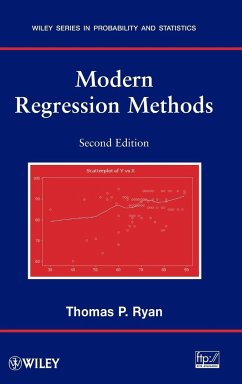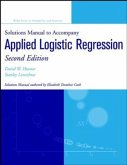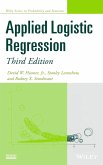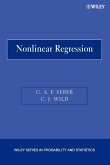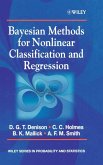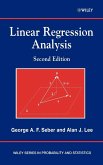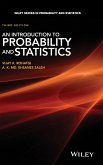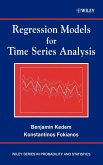Thomas P. Ryan
Modern Regression Methods
Thomas P. Ryan
Modern Regression Methods
- Gebundenes Buch
- Merkliste
- Auf die Merkliste
- Bewerten Bewerten
- Teilen
- Produkt teilen
- Produkterinnerung
- Produkterinnerung
Praise for the First Edition
". . . provides a very thorough treatment of regression approaches,
including techniques not covered in many books . . ." -Technometrics
". . . an excellent book . . . worthwhile for anyone who uses regression techniques to obtain their own copy of this book . . ." - Australian & New Zealand Journal of Statistics
Modern Regression Methods, Second Edition maintains the accessible organization, breadth of coverage, and cutting-edge appeal that earned its predecessor the title of being one of the top five books for statisticians by an Amstat News book…mehr
Andere Kunden interessierten sich auch für
![Applied Logistic Regression Applied Logistic Regression]() David W. HosmerApplied Logistic Regression62,99 €
David W. HosmerApplied Logistic Regression62,99 €![Applied Logistic Regression 3e Applied Logistic Regression 3e]() David W. HosmerApplied Logistic Regression 3e154,99 €
David W. HosmerApplied Logistic Regression 3e154,99 €![Nonlinear Regression Nonlinear Regression]() George A. F. SeberNonlinear Regression168,99 €
George A. F. SeberNonlinear Regression168,99 €![Bayesian Methods for Nonlinear Classification and Regression Bayesian Methods for Nonlinear Classification and Regression]() David G. T. DenisonBayesian Methods for Nonlinear Classification and Regression170,99 €
David G. T. DenisonBayesian Methods for Nonlinear Classification and Regression170,99 €![Linear Regression Analysis Linear Regression Analysis]() George A. F. SeberLinear Regression Analysis180,99 €
George A. F. SeberLinear Regression Analysis180,99 €![An Introduction to Probability and Statistics An Introduction to Probability and Statistics]() Vijay K. RohatgiAn Introduction to Probability and Statistics130,99 €
Vijay K. RohatgiAn Introduction to Probability and Statistics130,99 €![Regression Models for Time Series Analysis Regression Models for Time Series Analysis]() Benjamin KedemRegression Models for Time Series Analysis189,99 €
Benjamin KedemRegression Models for Time Series Analysis189,99 €-
-
-
Praise for the First Edition
". . . provides a very thorough treatment of regression approaches,
including techniques not covered in many books . . ."
-Technometrics
". . . an excellent book . . . worthwhile for anyone who uses regression techniques to obtain their own copy of this book . . ."
- Australian & New Zealand Journal of Statistics
Modern Regression Methods, Second Edition maintains the accessible organization, breadth of coverage, and cutting-edge appeal that earned its predecessor the title of being one of the top five books for statisticians by an Amstat News book editor in 2003. This new edition has been updated and enhanced to include all-new information on the latest advances and research in the evolving field of regression analysis.
The book provides a unique treatment of fundamental regression methods, such as diagnostics, transformations, robust regression, and ridge regression. Unifying key concepts and procedures, this new edition emphasizes applications to provide a more hands-on and comprehensive understanding of regression diagnostics. New features of the Second Edition include:
A revised chapter on logistic regression, including improved methods of parameter estimation
A new chapter focusing on additional topics of study in regression, including quantile regression, semiparametric regression, and Poisson regression
A wealth of new and updated exercises with worked solutions
An extensive FTP site complete with Minitab(r) macros, which allow the reader to compute analyses, and specialized procedures
Updated references at the end of each chapter that direct the reader to the appropriate resources for further study
An accessible guide to state-of-the-art regression techniques, Modern Regression Methods, Second Edition is an excellent book for courses in regression analysis at the upper-undergraduate and graduate levels. It is also a valuable reference for practicing statisticians, engineers, and physical scientists.
". . . provides a very thorough treatment of regression approaches,
including techniques not covered in many books . . ."
-Technometrics
". . . an excellent book . . . worthwhile for anyone who uses regression techniques to obtain their own copy of this book . . ."
- Australian & New Zealand Journal of Statistics
Modern Regression Methods, Second Edition maintains the accessible organization, breadth of coverage, and cutting-edge appeal that earned its predecessor the title of being one of the top five books for statisticians by an Amstat News book editor in 2003. This new edition has been updated and enhanced to include all-new information on the latest advances and research in the evolving field of regression analysis.
The book provides a unique treatment of fundamental regression methods, such as diagnostics, transformations, robust regression, and ridge regression. Unifying key concepts and procedures, this new edition emphasizes applications to provide a more hands-on and comprehensive understanding of regression diagnostics. New features of the Second Edition include:
A revised chapter on logistic regression, including improved methods of parameter estimation
A new chapter focusing on additional topics of study in regression, including quantile regression, semiparametric regression, and Poisson regression
A wealth of new and updated exercises with worked solutions
An extensive FTP site complete with Minitab(r) macros, which allow the reader to compute analyses, and specialized procedures
Updated references at the end of each chapter that direct the reader to the appropriate resources for further study
An accessible guide to state-of-the-art regression techniques, Modern Regression Methods, Second Edition is an excellent book for courses in regression analysis at the upper-undergraduate and graduate levels. It is also a valuable reference for practicing statisticians, engineers, and physical scientists.
Produktdetails
- Produktdetails
- Wiley Series in Probability and Statistics
- Verlag: Wiley & Sons
- 2. Aufl.
- Seitenzahl: 672
- Erscheinungstermin: 1. Oktober 2008
- Englisch
- Abmessung: 240mm x 161mm x 40mm
- Gewicht: 1038g
- ISBN-13: 9780470081860
- ISBN-10: 0470081864
- Artikelnr.: 23818765
- Herstellerkennzeichnung
- Libri GmbH
- Europaallee 1
- 36244 Bad Hersfeld
- gpsr@libri.de
- Wiley Series in Probability and Statistics
- Verlag: Wiley & Sons
- 2. Aufl.
- Seitenzahl: 672
- Erscheinungstermin: 1. Oktober 2008
- Englisch
- Abmessung: 240mm x 161mm x 40mm
- Gewicht: 1038g
- ISBN-13: 9780470081860
- ISBN-10: 0470081864
- Artikelnr.: 23818765
- Herstellerkennzeichnung
- Libri GmbH
- Europaallee 1
- 36244 Bad Hersfeld
- gpsr@libri.de
Ryan is a young author who writes Christian books and articles.
Preface.
1. Introduction.
1.1 Simple Linear Regression Model.
1.2 Uses of Regression Models.
1.3 Graph the Data!
1.4 Estimation of ß0 and ß1.
1.5 Inferences from Regression Equations.
1.6 Regression Through the Origin.
1.7 Additional Examples.
1.8 Correlation.
1.9 Miscellaneous Uses of Regression.
1.10 Fixed Versus Random Regressors.
1.11 Missing Data.
1.12 Spurious Relationships.
1.13 Software.
1.14 Summary.
Appendix.
References.
Exercises.
2. Diagnostics and Remedial Measures.
2.1 Assumptions.
2.2 Residual Plots.
2.3 Transformations.
2.4 Influential Observations.
2.5 Outliers.
2.6 Measurement Error.
2.7 Software.
2.8 Summary.
Appendix.
References.
Exercises.
3. Regression with Matrix Algebra.
3.1 Introduction to Matrix Algebra.
3.2 Matrix Algebra Applied to Regression.
3.3 Summary.
Appendix.
References.
Exercises.
4. Introduction to Multiple Linear Regression.
4.1 An Example of Multiple Linear Regression.
4.2 Centering And Scaling.
4.3 Interpreting Multiple Regression Coefficients.
4.4 Indicator Variables.
4.5 Separation or Not?
4.6 Alternatives to Multiple Regression.
4.7 Software.
4.8 Summary.
References.
Exercises.
5. Plots in Multiple Regression.
5.1 Beyond Standardized Residual Plots.
5.2 Some Examples.
5.3 Which Plot?
5.4 Recommendations.
5.5 Partial Regression Plots.
5.6 Other Plots For Detecting Influential Observations.
5.7 Recent Contributions to Plots in Multiple Regression.
5.8 Lurking Variables.
5.9 Explanation of Two Data Sets Relative to R2.
5.10 Software.
5.11 Summary.
References.
Exercises.
6. Transformations in Multiple Regression.
6.1 Transforming Regressors.
6.2 Transforming Y.
6.3 Further Comments on the Normality Issue.
6.4 Box-Cox Transformation.
6.5 Box-Tidwell Revisited.
6.6 Combined Box-Cox and Box-Tidwell Approach.
6.7 Other Transformation Methods.
6.8 Transformation Diagnostics.
6.9 Software.
6.10 Summary.
References.
Exercises.
7. Selection of Regressors.
7.1 Forward Selection.
7.2 Backward Elimination.
7.3 Stepwise Regression.
7.4 All Possible Regressions.
7.5 Newer Methods.
7.6 Examples.
7.7 Variable Selection for Nonlinear Terms.
7.8 Must We Use a Subset?
7.9 Model Validation.
7.10 Software.
7.11 Summary.
Appendix.
References.
Exercises.
8. Polynomial and Trigonometric Terms.
8.1 Polynomial Terms.
8.2 Polynomial-Trigonometric Regression.
8.3 Software.
8.4 Summary.
References.
Exercises.
9. Logistic Regression.
9.1 Introduction.
9.2 One Regressor.
9.3 A Simulated Example.
9.4 Detecting Complete Separation, Quasicomplete Separation and Near
Separation.
9.5 Measuring the Worth of the Model.
9.6 Determining the Worth of the Individual Regressors.
9.7 Confidence Intervals.
9.8 Exact Prediction.
9.9 An Example With Real Data.
9.10 An Example of Multiple Logistic Regression.
9.11 Multicollinearity in Multiple Logistic Regression.
9.12 Osteogenic Sarcoma Data Set.
9.13 Missing Data.
9.14 Sample Size Determination.
9.15 Polytomous Logistic Regression.
9.16 Logistic Regression Variations.
9.17 Alternatives to Logistic Regression.
9.18 Software for Logistic Regression.
9.19 Summary.
Appendix.
References.
Exercises.
10. Nonparametric Regression.
10.1 Relaxing Regression Assumptions.
10.2 Monotone Regression.
10.3 Smoothers.
10.4 Variable Selection.
10.5 Important Considerations in Smoothing.
10.6 Sliced Inverse Regression.
10.7 Projection Pursuit Regression.
10.8 Software.
10.9 Summary.
Appendix.
References.
Exercises.
11. Robust Regression.
11.1 The Need for Robust Regression.
11.2 Types of Outliers.
11.3 Historical Development of Robust Regression.
11.4 Goals of Robust Regression.
11.5 Proposed High Breakdown Point Estimators.
11.6 Approximating HBP Estimator Solutions.
11.7 Other Methods for Detecting Multiple Outliers.
11.8 Bounded Influence Estimators.
11.9 Multistage Procedures.
11.10 Other Robust Regression Estimators.
11.11 Applications.
11.12 Software for Robust Regression.
11.13 Summary.
References.
Exercises.
12. Ridge Regression.
12.1 Introduction.
12.2 How Do We Determine K?
12.3 An Example.
12.4 Ridge Regression for Prediction.
12.5 Generalized Ridge Regression.
12.6 Inferences in Ridge Regression.
12.7 Some Practical Considerations.
12.8 Robust Ridge Regression?
12.9 Recent Developments in Ridge Regression.
12.10 Other Biased Estimators.
12.11 Software.
12.12 Summary.
Appendix.
References.
Exercises.
13. Nonlinear Regression.
13.1 Introduction.
13.2 Linear Versus Nonlinear Regression.
13.3 A Simple Nonlinear Example.
13.4 Relative Offset Convergence Criterion.
13.5 Adequacy of the Estimation Approach.
13.6 Computational Considerations.
13.7 Determining Model Adequacy.
13.7.1 Lack-of-Fit Test.
13.8 Inferences.
13.9 An Application.
13.10 Rational Functions.
13.11 Robust Nonlinear Regression.
13.12 Applications.
13.13 Teaching Tools.
13.14 Recent Developments.
13.15 Software.
13.16 Summary.
Appendix.
References.
Exercises.
14. Experimental Designs for Regression.
14.1 Objectives for Experimental Designs.
14.2 Equal Leverage Points.
14.3 Other Desirable Properties of Experimental Designs.
14.4 Model Misspecification.
14.5 Range of Regressors.
14.6 Algorithms for Design Construction.
14.7 Designs for Polynomial Regression.
14.8 Designs for Logistic Regression.
14.9 Designs for Nonlinear Regression.
14.10 Software.
14.11 Summary.
References.
Exercises.
15. Miscellaneous Topics in Regression.
15.1 Piecewise Regression and Alternatives.
15.2 Semiparametric Regression.
15.3 Quantile Regression.
15.4 Poisson Regression.
15.5 Negative Binomial Regression.
15.6 Cox Regression.
15.7 Probit Regression.
15.8 Censored Regression and Truncated Regression.
15.8.1 Tobit Regression.
15.9 Constrained Regression.
15.10 Interval Regression.
15.11 Random Coefficient Regression.
15.12 Partial Least Squares Regression.
15.13 Errors-in-Variables Regression.
15.14 Regression with Life Data.
15.15 Use of Regression in Survey Sampling.
15.16 Bayesian Regression.
15.17 Instrumental Variables Regression.
15.18 Shrinkage Estimators.
15.19 Meta-Regression.
15.20 Classification and Regression Trees (CART).
15.21 Multivariate Regression.
References.
Exercises.
16. Analysis of Real Data Sets.
16.1 Analyzing Buchanan's Presidential Vote in Palm Beach County in 2000.
16.2 Water Quality Data.
16.3 Predicting Lifespan?
16.4 Scottish Hill Races Data.
16.5 Leukemia Data.
16.6 Dosage Response Data.
16.7 A Strategy for Analyzing Regression Data.
16.8 Summary.
References.
Answers to Selected Exercises.
Statistical Tables.
Author Index.
Subject Index.
1. Introduction.
1.1 Simple Linear Regression Model.
1.2 Uses of Regression Models.
1.3 Graph the Data!
1.4 Estimation of ß0 and ß1.
1.5 Inferences from Regression Equations.
1.6 Regression Through the Origin.
1.7 Additional Examples.
1.8 Correlation.
1.9 Miscellaneous Uses of Regression.
1.10 Fixed Versus Random Regressors.
1.11 Missing Data.
1.12 Spurious Relationships.
1.13 Software.
1.14 Summary.
Appendix.
References.
Exercises.
2. Diagnostics and Remedial Measures.
2.1 Assumptions.
2.2 Residual Plots.
2.3 Transformations.
2.4 Influential Observations.
2.5 Outliers.
2.6 Measurement Error.
2.7 Software.
2.8 Summary.
Appendix.
References.
Exercises.
3. Regression with Matrix Algebra.
3.1 Introduction to Matrix Algebra.
3.2 Matrix Algebra Applied to Regression.
3.3 Summary.
Appendix.
References.
Exercises.
4. Introduction to Multiple Linear Regression.
4.1 An Example of Multiple Linear Regression.
4.2 Centering And Scaling.
4.3 Interpreting Multiple Regression Coefficients.
4.4 Indicator Variables.
4.5 Separation or Not?
4.6 Alternatives to Multiple Regression.
4.7 Software.
4.8 Summary.
References.
Exercises.
5. Plots in Multiple Regression.
5.1 Beyond Standardized Residual Plots.
5.2 Some Examples.
5.3 Which Plot?
5.4 Recommendations.
5.5 Partial Regression Plots.
5.6 Other Plots For Detecting Influential Observations.
5.7 Recent Contributions to Plots in Multiple Regression.
5.8 Lurking Variables.
5.9 Explanation of Two Data Sets Relative to R2.
5.10 Software.
5.11 Summary.
References.
Exercises.
6. Transformations in Multiple Regression.
6.1 Transforming Regressors.
6.2 Transforming Y.
6.3 Further Comments on the Normality Issue.
6.4 Box-Cox Transformation.
6.5 Box-Tidwell Revisited.
6.6 Combined Box-Cox and Box-Tidwell Approach.
6.7 Other Transformation Methods.
6.8 Transformation Diagnostics.
6.9 Software.
6.10 Summary.
References.
Exercises.
7. Selection of Regressors.
7.1 Forward Selection.
7.2 Backward Elimination.
7.3 Stepwise Regression.
7.4 All Possible Regressions.
7.5 Newer Methods.
7.6 Examples.
7.7 Variable Selection for Nonlinear Terms.
7.8 Must We Use a Subset?
7.9 Model Validation.
7.10 Software.
7.11 Summary.
Appendix.
References.
Exercises.
8. Polynomial and Trigonometric Terms.
8.1 Polynomial Terms.
8.2 Polynomial-Trigonometric Regression.
8.3 Software.
8.4 Summary.
References.
Exercises.
9. Logistic Regression.
9.1 Introduction.
9.2 One Regressor.
9.3 A Simulated Example.
9.4 Detecting Complete Separation, Quasicomplete Separation and Near
Separation.
9.5 Measuring the Worth of the Model.
9.6 Determining the Worth of the Individual Regressors.
9.7 Confidence Intervals.
9.8 Exact Prediction.
9.9 An Example With Real Data.
9.10 An Example of Multiple Logistic Regression.
9.11 Multicollinearity in Multiple Logistic Regression.
9.12 Osteogenic Sarcoma Data Set.
9.13 Missing Data.
9.14 Sample Size Determination.
9.15 Polytomous Logistic Regression.
9.16 Logistic Regression Variations.
9.17 Alternatives to Logistic Regression.
9.18 Software for Logistic Regression.
9.19 Summary.
Appendix.
References.
Exercises.
10. Nonparametric Regression.
10.1 Relaxing Regression Assumptions.
10.2 Monotone Regression.
10.3 Smoothers.
10.4 Variable Selection.
10.5 Important Considerations in Smoothing.
10.6 Sliced Inverse Regression.
10.7 Projection Pursuit Regression.
10.8 Software.
10.9 Summary.
Appendix.
References.
Exercises.
11. Robust Regression.
11.1 The Need for Robust Regression.
11.2 Types of Outliers.
11.3 Historical Development of Robust Regression.
11.4 Goals of Robust Regression.
11.5 Proposed High Breakdown Point Estimators.
11.6 Approximating HBP Estimator Solutions.
11.7 Other Methods for Detecting Multiple Outliers.
11.8 Bounded Influence Estimators.
11.9 Multistage Procedures.
11.10 Other Robust Regression Estimators.
11.11 Applications.
11.12 Software for Robust Regression.
11.13 Summary.
References.
Exercises.
12. Ridge Regression.
12.1 Introduction.
12.2 How Do We Determine K?
12.3 An Example.
12.4 Ridge Regression for Prediction.
12.5 Generalized Ridge Regression.
12.6 Inferences in Ridge Regression.
12.7 Some Practical Considerations.
12.8 Robust Ridge Regression?
12.9 Recent Developments in Ridge Regression.
12.10 Other Biased Estimators.
12.11 Software.
12.12 Summary.
Appendix.
References.
Exercises.
13. Nonlinear Regression.
13.1 Introduction.
13.2 Linear Versus Nonlinear Regression.
13.3 A Simple Nonlinear Example.
13.4 Relative Offset Convergence Criterion.
13.5 Adequacy of the Estimation Approach.
13.6 Computational Considerations.
13.7 Determining Model Adequacy.
13.7.1 Lack-of-Fit Test.
13.8 Inferences.
13.9 An Application.
13.10 Rational Functions.
13.11 Robust Nonlinear Regression.
13.12 Applications.
13.13 Teaching Tools.
13.14 Recent Developments.
13.15 Software.
13.16 Summary.
Appendix.
References.
Exercises.
14. Experimental Designs for Regression.
14.1 Objectives for Experimental Designs.
14.2 Equal Leverage Points.
14.3 Other Desirable Properties of Experimental Designs.
14.4 Model Misspecification.
14.5 Range of Regressors.
14.6 Algorithms for Design Construction.
14.7 Designs for Polynomial Regression.
14.8 Designs for Logistic Regression.
14.9 Designs for Nonlinear Regression.
14.10 Software.
14.11 Summary.
References.
Exercises.
15. Miscellaneous Topics in Regression.
15.1 Piecewise Regression and Alternatives.
15.2 Semiparametric Regression.
15.3 Quantile Regression.
15.4 Poisson Regression.
15.5 Negative Binomial Regression.
15.6 Cox Regression.
15.7 Probit Regression.
15.8 Censored Regression and Truncated Regression.
15.8.1 Tobit Regression.
15.9 Constrained Regression.
15.10 Interval Regression.
15.11 Random Coefficient Regression.
15.12 Partial Least Squares Regression.
15.13 Errors-in-Variables Regression.
15.14 Regression with Life Data.
15.15 Use of Regression in Survey Sampling.
15.16 Bayesian Regression.
15.17 Instrumental Variables Regression.
15.18 Shrinkage Estimators.
15.19 Meta-Regression.
15.20 Classification and Regression Trees (CART).
15.21 Multivariate Regression.
References.
Exercises.
16. Analysis of Real Data Sets.
16.1 Analyzing Buchanan's Presidential Vote in Palm Beach County in 2000.
16.2 Water Quality Data.
16.3 Predicting Lifespan?
16.4 Scottish Hill Races Data.
16.5 Leukemia Data.
16.6 Dosage Response Data.
16.7 A Strategy for Analyzing Regression Data.
16.8 Summary.
References.
Answers to Selected Exercises.
Statistical Tables.
Author Index.
Subject Index.
Preface.
1. Introduction.
1.1 Simple Linear Regression Model.
1.2 Uses of Regression Models.
1.3 Graph the Data!
1.4 Estimation of ß0 and ß1.
1.5 Inferences from Regression Equations.
1.6 Regression Through the Origin.
1.7 Additional Examples.
1.8 Correlation.
1.9 Miscellaneous Uses of Regression.
1.10 Fixed Versus Random Regressors.
1.11 Missing Data.
1.12 Spurious Relationships.
1.13 Software.
1.14 Summary.
Appendix.
References.
Exercises.
2. Diagnostics and Remedial Measures.
2.1 Assumptions.
2.2 Residual Plots.
2.3 Transformations.
2.4 Influential Observations.
2.5 Outliers.
2.6 Measurement Error.
2.7 Software.
2.8 Summary.
Appendix.
References.
Exercises.
3. Regression with Matrix Algebra.
3.1 Introduction to Matrix Algebra.
3.2 Matrix Algebra Applied to Regression.
3.3 Summary.
Appendix.
References.
Exercises.
4. Introduction to Multiple Linear Regression.
4.1 An Example of Multiple Linear Regression.
4.2 Centering And Scaling.
4.3 Interpreting Multiple Regression Coefficients.
4.4 Indicator Variables.
4.5 Separation or Not?
4.6 Alternatives to Multiple Regression.
4.7 Software.
4.8 Summary.
References.
Exercises.
5. Plots in Multiple Regression.
5.1 Beyond Standardized Residual Plots.
5.2 Some Examples.
5.3 Which Plot?
5.4 Recommendations.
5.5 Partial Regression Plots.
5.6 Other Plots For Detecting Influential Observations.
5.7 Recent Contributions to Plots in Multiple Regression.
5.8 Lurking Variables.
5.9 Explanation of Two Data Sets Relative to R2.
5.10 Software.
5.11 Summary.
References.
Exercises.
6. Transformations in Multiple Regression.
6.1 Transforming Regressors.
6.2 Transforming Y.
6.3 Further Comments on the Normality Issue.
6.4 Box-Cox Transformation.
6.5 Box-Tidwell Revisited.
6.6 Combined Box-Cox and Box-Tidwell Approach.
6.7 Other Transformation Methods.
6.8 Transformation Diagnostics.
6.9 Software.
6.10 Summary.
References.
Exercises.
7. Selection of Regressors.
7.1 Forward Selection.
7.2 Backward Elimination.
7.3 Stepwise Regression.
7.4 All Possible Regressions.
7.5 Newer Methods.
7.6 Examples.
7.7 Variable Selection for Nonlinear Terms.
7.8 Must We Use a Subset?
7.9 Model Validation.
7.10 Software.
7.11 Summary.
Appendix.
References.
Exercises.
8. Polynomial and Trigonometric Terms.
8.1 Polynomial Terms.
8.2 Polynomial-Trigonometric Regression.
8.3 Software.
8.4 Summary.
References.
Exercises.
9. Logistic Regression.
9.1 Introduction.
9.2 One Regressor.
9.3 A Simulated Example.
9.4 Detecting Complete Separation, Quasicomplete Separation and Near
Separation.
9.5 Measuring the Worth of the Model.
9.6 Determining the Worth of the Individual Regressors.
9.7 Confidence Intervals.
9.8 Exact Prediction.
9.9 An Example With Real Data.
9.10 An Example of Multiple Logistic Regression.
9.11 Multicollinearity in Multiple Logistic Regression.
9.12 Osteogenic Sarcoma Data Set.
9.13 Missing Data.
9.14 Sample Size Determination.
9.15 Polytomous Logistic Regression.
9.16 Logistic Regression Variations.
9.17 Alternatives to Logistic Regression.
9.18 Software for Logistic Regression.
9.19 Summary.
Appendix.
References.
Exercises.
10. Nonparametric Regression.
10.1 Relaxing Regression Assumptions.
10.2 Monotone Regression.
10.3 Smoothers.
10.4 Variable Selection.
10.5 Important Considerations in Smoothing.
10.6 Sliced Inverse Regression.
10.7 Projection Pursuit Regression.
10.8 Software.
10.9 Summary.
Appendix.
References.
Exercises.
11. Robust Regression.
11.1 The Need for Robust Regression.
11.2 Types of Outliers.
11.3 Historical Development of Robust Regression.
11.4 Goals of Robust Regression.
11.5 Proposed High Breakdown Point Estimators.
11.6 Approximating HBP Estimator Solutions.
11.7 Other Methods for Detecting Multiple Outliers.
11.8 Bounded Influence Estimators.
11.9 Multistage Procedures.
11.10 Other Robust Regression Estimators.
11.11 Applications.
11.12 Software for Robust Regression.
11.13 Summary.
References.
Exercises.
12. Ridge Regression.
12.1 Introduction.
12.2 How Do We Determine K?
12.3 An Example.
12.4 Ridge Regression for Prediction.
12.5 Generalized Ridge Regression.
12.6 Inferences in Ridge Regression.
12.7 Some Practical Considerations.
12.8 Robust Ridge Regression?
12.9 Recent Developments in Ridge Regression.
12.10 Other Biased Estimators.
12.11 Software.
12.12 Summary.
Appendix.
References.
Exercises.
13. Nonlinear Regression.
13.1 Introduction.
13.2 Linear Versus Nonlinear Regression.
13.3 A Simple Nonlinear Example.
13.4 Relative Offset Convergence Criterion.
13.5 Adequacy of the Estimation Approach.
13.6 Computational Considerations.
13.7 Determining Model Adequacy.
13.7.1 Lack-of-Fit Test.
13.8 Inferences.
13.9 An Application.
13.10 Rational Functions.
13.11 Robust Nonlinear Regression.
13.12 Applications.
13.13 Teaching Tools.
13.14 Recent Developments.
13.15 Software.
13.16 Summary.
Appendix.
References.
Exercises.
14. Experimental Designs for Regression.
14.1 Objectives for Experimental Designs.
14.2 Equal Leverage Points.
14.3 Other Desirable Properties of Experimental Designs.
14.4 Model Misspecification.
14.5 Range of Regressors.
14.6 Algorithms for Design Construction.
14.7 Designs for Polynomial Regression.
14.8 Designs for Logistic Regression.
14.9 Designs for Nonlinear Regression.
14.10 Software.
14.11 Summary.
References.
Exercises.
15. Miscellaneous Topics in Regression.
15.1 Piecewise Regression and Alternatives.
15.2 Semiparametric Regression.
15.3 Quantile Regression.
15.4 Poisson Regression.
15.5 Negative Binomial Regression.
15.6 Cox Regression.
15.7 Probit Regression.
15.8 Censored Regression and Truncated Regression.
15.8.1 Tobit Regression.
15.9 Constrained Regression.
15.10 Interval Regression.
15.11 Random Coefficient Regression.
15.12 Partial Least Squares Regression.
15.13 Errors-in-Variables Regression.
15.14 Regression with Life Data.
15.15 Use of Regression in Survey Sampling.
15.16 Bayesian Regression.
15.17 Instrumental Variables Regression.
15.18 Shrinkage Estimators.
15.19 Meta-Regression.
15.20 Classification and Regression Trees (CART).
15.21 Multivariate Regression.
References.
Exercises.
16. Analysis of Real Data Sets.
16.1 Analyzing Buchanan's Presidential Vote in Palm Beach County in 2000.
16.2 Water Quality Data.
16.3 Predicting Lifespan?
16.4 Scottish Hill Races Data.
16.5 Leukemia Data.
16.6 Dosage Response Data.
16.7 A Strategy for Analyzing Regression Data.
16.8 Summary.
References.
Answers to Selected Exercises.
Statistical Tables.
Author Index.
Subject Index.
1. Introduction.
1.1 Simple Linear Regression Model.
1.2 Uses of Regression Models.
1.3 Graph the Data!
1.4 Estimation of ß0 and ß1.
1.5 Inferences from Regression Equations.
1.6 Regression Through the Origin.
1.7 Additional Examples.
1.8 Correlation.
1.9 Miscellaneous Uses of Regression.
1.10 Fixed Versus Random Regressors.
1.11 Missing Data.
1.12 Spurious Relationships.
1.13 Software.
1.14 Summary.
Appendix.
References.
Exercises.
2. Diagnostics and Remedial Measures.
2.1 Assumptions.
2.2 Residual Plots.
2.3 Transformations.
2.4 Influential Observations.
2.5 Outliers.
2.6 Measurement Error.
2.7 Software.
2.8 Summary.
Appendix.
References.
Exercises.
3. Regression with Matrix Algebra.
3.1 Introduction to Matrix Algebra.
3.2 Matrix Algebra Applied to Regression.
3.3 Summary.
Appendix.
References.
Exercises.
4. Introduction to Multiple Linear Regression.
4.1 An Example of Multiple Linear Regression.
4.2 Centering And Scaling.
4.3 Interpreting Multiple Regression Coefficients.
4.4 Indicator Variables.
4.5 Separation or Not?
4.6 Alternatives to Multiple Regression.
4.7 Software.
4.8 Summary.
References.
Exercises.
5. Plots in Multiple Regression.
5.1 Beyond Standardized Residual Plots.
5.2 Some Examples.
5.3 Which Plot?
5.4 Recommendations.
5.5 Partial Regression Plots.
5.6 Other Plots For Detecting Influential Observations.
5.7 Recent Contributions to Plots in Multiple Regression.
5.8 Lurking Variables.
5.9 Explanation of Two Data Sets Relative to R2.
5.10 Software.
5.11 Summary.
References.
Exercises.
6. Transformations in Multiple Regression.
6.1 Transforming Regressors.
6.2 Transforming Y.
6.3 Further Comments on the Normality Issue.
6.4 Box-Cox Transformation.
6.5 Box-Tidwell Revisited.
6.6 Combined Box-Cox and Box-Tidwell Approach.
6.7 Other Transformation Methods.
6.8 Transformation Diagnostics.
6.9 Software.
6.10 Summary.
References.
Exercises.
7. Selection of Regressors.
7.1 Forward Selection.
7.2 Backward Elimination.
7.3 Stepwise Regression.
7.4 All Possible Regressions.
7.5 Newer Methods.
7.6 Examples.
7.7 Variable Selection for Nonlinear Terms.
7.8 Must We Use a Subset?
7.9 Model Validation.
7.10 Software.
7.11 Summary.
Appendix.
References.
Exercises.
8. Polynomial and Trigonometric Terms.
8.1 Polynomial Terms.
8.2 Polynomial-Trigonometric Regression.
8.3 Software.
8.4 Summary.
References.
Exercises.
9. Logistic Regression.
9.1 Introduction.
9.2 One Regressor.
9.3 A Simulated Example.
9.4 Detecting Complete Separation, Quasicomplete Separation and Near
Separation.
9.5 Measuring the Worth of the Model.
9.6 Determining the Worth of the Individual Regressors.
9.7 Confidence Intervals.
9.8 Exact Prediction.
9.9 An Example With Real Data.
9.10 An Example of Multiple Logistic Regression.
9.11 Multicollinearity in Multiple Logistic Regression.
9.12 Osteogenic Sarcoma Data Set.
9.13 Missing Data.
9.14 Sample Size Determination.
9.15 Polytomous Logistic Regression.
9.16 Logistic Regression Variations.
9.17 Alternatives to Logistic Regression.
9.18 Software for Logistic Regression.
9.19 Summary.
Appendix.
References.
Exercises.
10. Nonparametric Regression.
10.1 Relaxing Regression Assumptions.
10.2 Monotone Regression.
10.3 Smoothers.
10.4 Variable Selection.
10.5 Important Considerations in Smoothing.
10.6 Sliced Inverse Regression.
10.7 Projection Pursuit Regression.
10.8 Software.
10.9 Summary.
Appendix.
References.
Exercises.
11. Robust Regression.
11.1 The Need for Robust Regression.
11.2 Types of Outliers.
11.3 Historical Development of Robust Regression.
11.4 Goals of Robust Regression.
11.5 Proposed High Breakdown Point Estimators.
11.6 Approximating HBP Estimator Solutions.
11.7 Other Methods for Detecting Multiple Outliers.
11.8 Bounded Influence Estimators.
11.9 Multistage Procedures.
11.10 Other Robust Regression Estimators.
11.11 Applications.
11.12 Software for Robust Regression.
11.13 Summary.
References.
Exercises.
12. Ridge Regression.
12.1 Introduction.
12.2 How Do We Determine K?
12.3 An Example.
12.4 Ridge Regression for Prediction.
12.5 Generalized Ridge Regression.
12.6 Inferences in Ridge Regression.
12.7 Some Practical Considerations.
12.8 Robust Ridge Regression?
12.9 Recent Developments in Ridge Regression.
12.10 Other Biased Estimators.
12.11 Software.
12.12 Summary.
Appendix.
References.
Exercises.
13. Nonlinear Regression.
13.1 Introduction.
13.2 Linear Versus Nonlinear Regression.
13.3 A Simple Nonlinear Example.
13.4 Relative Offset Convergence Criterion.
13.5 Adequacy of the Estimation Approach.
13.6 Computational Considerations.
13.7 Determining Model Adequacy.
13.7.1 Lack-of-Fit Test.
13.8 Inferences.
13.9 An Application.
13.10 Rational Functions.
13.11 Robust Nonlinear Regression.
13.12 Applications.
13.13 Teaching Tools.
13.14 Recent Developments.
13.15 Software.
13.16 Summary.
Appendix.
References.
Exercises.
14. Experimental Designs for Regression.
14.1 Objectives for Experimental Designs.
14.2 Equal Leverage Points.
14.3 Other Desirable Properties of Experimental Designs.
14.4 Model Misspecification.
14.5 Range of Regressors.
14.6 Algorithms for Design Construction.
14.7 Designs for Polynomial Regression.
14.8 Designs for Logistic Regression.
14.9 Designs for Nonlinear Regression.
14.10 Software.
14.11 Summary.
References.
Exercises.
15. Miscellaneous Topics in Regression.
15.1 Piecewise Regression and Alternatives.
15.2 Semiparametric Regression.
15.3 Quantile Regression.
15.4 Poisson Regression.
15.5 Negative Binomial Regression.
15.6 Cox Regression.
15.7 Probit Regression.
15.8 Censored Regression and Truncated Regression.
15.8.1 Tobit Regression.
15.9 Constrained Regression.
15.10 Interval Regression.
15.11 Random Coefficient Regression.
15.12 Partial Least Squares Regression.
15.13 Errors-in-Variables Regression.
15.14 Regression with Life Data.
15.15 Use of Regression in Survey Sampling.
15.16 Bayesian Regression.
15.17 Instrumental Variables Regression.
15.18 Shrinkage Estimators.
15.19 Meta-Regression.
15.20 Classification and Regression Trees (CART).
15.21 Multivariate Regression.
References.
Exercises.
16. Analysis of Real Data Sets.
16.1 Analyzing Buchanan's Presidential Vote in Palm Beach County in 2000.
16.2 Water Quality Data.
16.3 Predicting Lifespan?
16.4 Scottish Hill Races Data.
16.5 Leukemia Data.
16.6 Dosage Response Data.
16.7 A Strategy for Analyzing Regression Data.
16.8 Summary.
References.
Answers to Selected Exercises.
Statistical Tables.
Author Index.
Subject Index.

